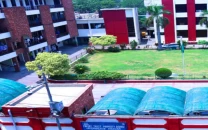If Karachi won’t pay its bills, KESC will keep cutting it off
Home users owe the utility up to Rs35b - no wonder circular debt keeps going around .

Karachi’ites enraged by power cuts tend to amass on the roads, burn a few tyres and chant slogans till the police show up with empty promises. The less ‘proacive’ stay glued to the phone, screaming down the helpline to the Karachi Electric Supply Company (KESC) staff for not restoring electricity to their area.
While it is true that KESC has not delivered on many of its promises, it is perhaps not fair to blame it for the entire situation. How long can Karachi expect free electricity and zero load shedding if large swathes of neighbourhoods do not pay their bills and steal power through kundas?
Break it, buy it
Both houses and factories owe KESC millions of rupees in unpaid bills. The figure is as high as Rs35 billion for private consumers.
If you want to know why your area has frequent power cuts, look no further than your neighbours. According to KESC, the behaviour of customers - both in paying their bills or stealing electricity (kunda) - dictates the number and duration of power cuts.
Areas are divided into low-loss, medium-loss and high-loss, which Ghufran Khan, the chief marketing communications officer at KESC, describes as “good, bad and ugly”. According to Khan, the “good” areas are those where power theft is far low and bill collection exceeds the ratios set by KESC. These areas are rewarded for good behaviour and experience no power cuts. In areas with moderate theft and issues with bill payment, there are three hours of power cuts. “Ugly” areas experience four-and-a-half hour power cuts.
Given how politicised the issue of power outages is in Karachi, it is hard to imagine how KESC would collect bill payments from party strongholds in the city.
“We have no issues saying ‘no’ to someone,” said Khan. “We have gone in and collected dues from Al Asif Square, Gulistan-e-Jauhar and Shireen Jinnah Colony, which had chronic problems.” He recounted KESC’s recent experience with collecting dues from Al Karam Square, an area dominated by one political party. “The area owed Rs430 million in arrears. We removed the transformers - if you just cut the power lines, they know how to fix them again.” Sure enough, the party representatives trotted up to KESC that explained it would be happy to replace the transformers if the bills were paid.
“We were assured we would be repaid so we replaced the transformers,” said Khan. “But after we received no money for a week, we took them out again.” The party representatives resurfaced and said that the consumers would pay their bills from then on, but not the arrears. KESC stuck to its guns and the supply was cut off for three days. As a result, the area’s residential associations signed an agreement with the utility, that was guaranteed by the party, and bill payment became regular. Government organisations, including the Rangers, Karachi Water and Sewerage Board (KWSB) and the City District Government Karachi (CDGK), owe KESC over Rs20 billion. KWSB alone needs to pay Rs14.5 billion.
On Friday, KESC issued notices to the latter two, asking them to pay up within three days otherwise the company would act against them. Since the KWSB and city government are ‘strategic customers’, KESC has to guarantee them a supply. According to KESC’s agreement with the government, if their debts are not paid within 90 days, they are transferred to the federal government.
Et tu, employees?
KESC spent the major part of this year embroiled in a dispute with the 4,000 union workers who it attempted to lay off. It took the federal and provincial government’s involvement and guarantees from the civil administration and union leaders for an agreement to be brokered. While the impasse went on, workers staged a long-running sit-in, allegedly sabotaged electricity installations, attacked KESC field staff and offices and set up a parallel “response team” to fix problems that they had created - and made a hefty packet from power-hungry Karachi’ites.
“Even then, we were still fixing complaints,” maintained Khan. “We would send staff out very late at night or early in the morning, while the union workers were asleep.” The situation was further complicated, however, by the fact that political parties supported the labour unions. Law enforcement agencies did not take action against workers who were doing damage to KESC property or attacking and blockading its offices.
According to Khan, there has been an “invisible go-slow strike” by 2,000 of their current field workers. “They will take 25 complaints instead of 50, spend hours on one complaint ... these things are difficult to catch.”
But firing or penalising another 2,000 employees is not something that KESC can currently afford to do. “If it were ]
that easy, we wouldn’t be discussing it,” Khan told The Express Tribune.
Brace yourself
While the hordes of chanting union workers may have disappeared from KESC’s headquarters off Sunset Boulevard, it appears that the sabotage persists. Power cuts have increased in length, with some areas cut off for up to eight hours. The response time for complaints has also increased. KESC insists that it has the capacity to provide electricity to Karachi. It just does not have the resources. It blames the government’s lack of political will and short-sightedness for its problems, primarily the lack of a promised gas supply.
Some relief has been forthcoming. On Friday evening, Federal Minister for Petroleum and Natural Resources Dr Asim Hussain directed the Sui Southern Gas Company (SSGC) to increase its gas supply to KESC to 180mmcfd (million cubic feet per day).
“If the federal government were to give us even 240 of the 276mmcfd that we were guaranteed, then we could go back to the old schedule of power cuts.”
It appears to be a vicious cycle. KESC can’t pay its debtors - the SSGC and Pakistan State Oil - until it is paid by consumers. The SSGC, in turn, scales back its supply to KESC because it has not been paid. The federal government can’t guarantee the gas supply that it promised KESC when it was privatised, and it appears unlikely that it will be able to do so for the new plants the power utility is setting up, which will be functional by 2012.
What can customers expect then if KESC’s demands or the government’s promises go unfulfilled?
“Status quo,” remarked Khan. “We have no choice but to increase power cuts to six, eight and 10 hours for the ‘good, bad and ugly’ areas, and eight hours for industrial users.”
Published in The Express Tribune, July 30th, 2011.



















COMMENTS
Comments are moderated and generally will be posted if they are on-topic and not abusive.
For more information, please see our Comments FAQ